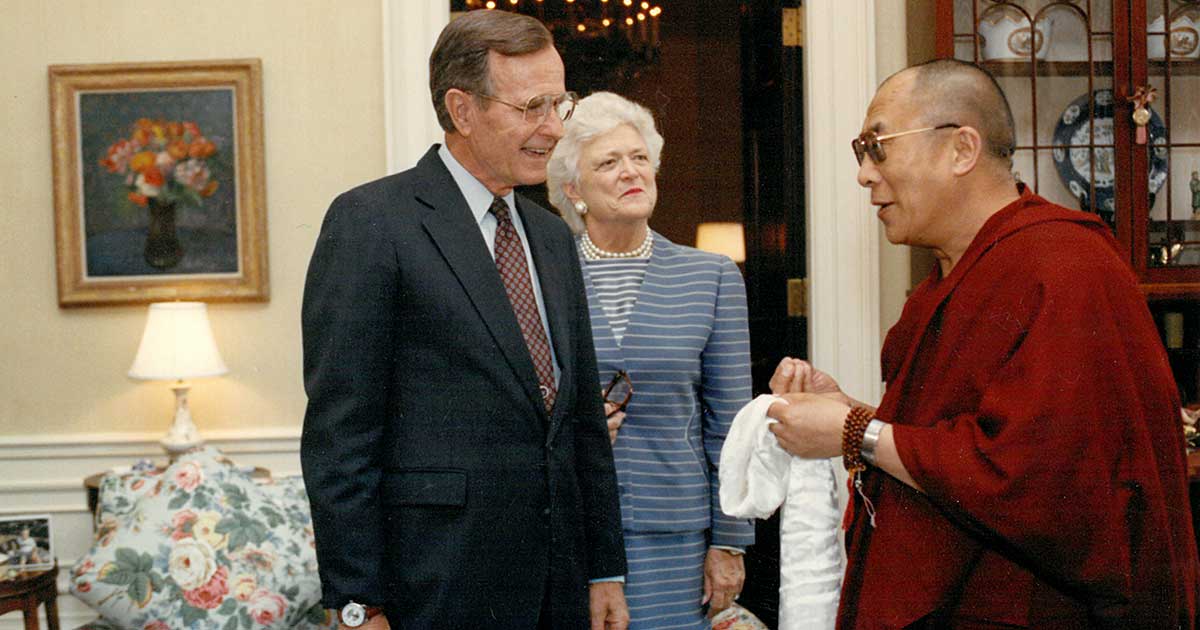
The Dalai Lama had his first meeting with a sitting US president on April 16, 1991. Here he is with President George H.W. Bush and First Lady Barbara Bush.
“America is the nation for championing liberty, democracy and freedom. America should stand on those principles … in international relations.”
Those words, admiring and assertive, come from an interview the Dalai Lama gave at the threshold of a historic event: his first meeting with a sitting president of the United States.
That auspicious gathering took place April, 16, 1991—30 years ago today. That evening, President George H.W. Bush welcomed His Holiness to the White House for a discussion about Tibet, the Himalayan homeland the Chinese Communist Party had forced the Dalai Lama to flee during a brutal conquest more than three decades earlier.
First Lady Barbara Bush took part in the meeting, as did several US and Tibetan officials, including the late International Campaign for Tibet Executive Chairman Lodi Gyari, who was the special envoy of His Holiness, and ICT’s founding President Tenzin Tethong, who was then the Tibetan foreign minister. Afterward, White House Press Secretary Marlin Fitzwater told reporters, “They discussed the general situation in Tibet … [The Dalai Lama]’s the religious leader of the country. The president felt it was appropriate to see him.”
The meeting—which the Chinese government tried furiously but futilely to prevent—only lasted about half an hour. But it was the start of something special. Over the next 25 years, every US president, regardless of their political party, spoke with the Dalai Lama in the White House, sending a clear signal to Beijing, and the world, about America’s enduring, bipartisan support for His Holiness’ vision of dialogue with China and meaningful autonomy for Tibet.
As Lodi Gyari said in “My Personal Words of Gratitude” upon his retirement: “This was the first meeting between His Holiness and an American president and it set the precedence for subsequent meetings between His Holiness and other world leaders.”
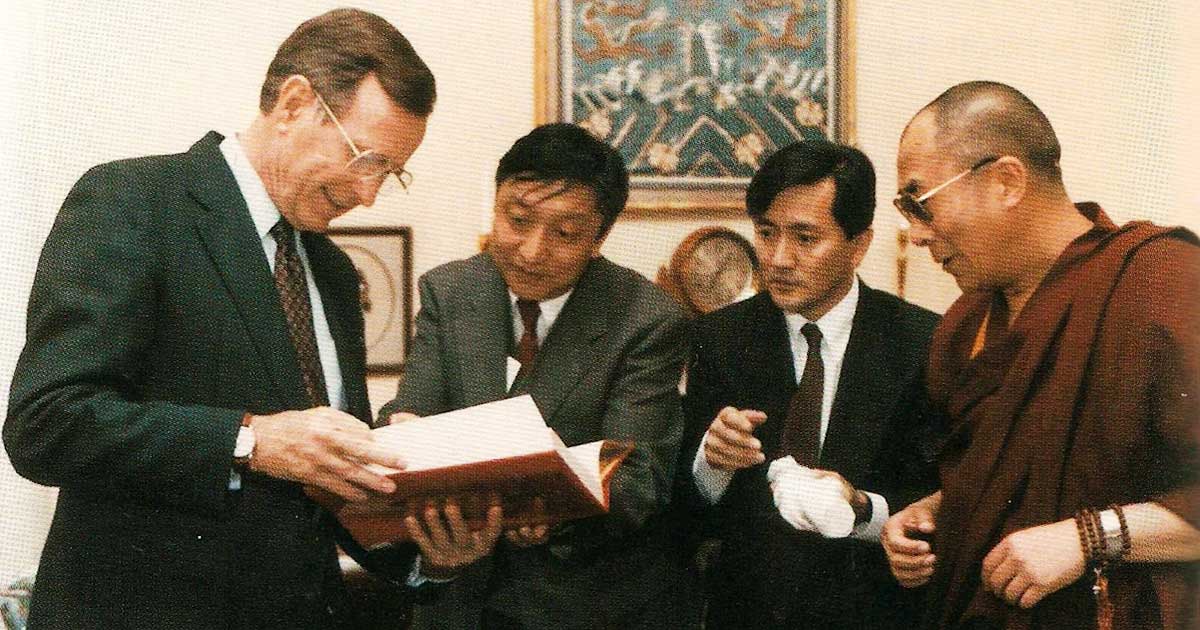
President George H.W. Bush, Special Envoy Lodi Gyari, Foreign Minister Tenzin Tethong and His Holiness the Dalai Lama.
Political and personal
I have no doubt that His Holiness meeting routinely with the most powerful person in the world helped elevate the Tibetan movement. Although he only met Bush—who lost reelection the next year—that one time while he was in office, the Dalai Lama convened in the White House four times each with Presidents Bill Clinton, George W. Bush and Barack Obama.
Each of them publicly voiced support for His Holiness’ efforts to resolve the Tibetan issue peacefully. They also spoke up for the Dalai Lama with Chinese leaders, most notably when Clinton pushed Chinese President Jiang Zemin to engage His Holiness in dialogue during a news conference that aired live on TV in China in 1998.
But the Dalai Lama’s relationship with the presidency appears to have been a two-way street. Commander-in-chief may be the most influential job in the world, but even presidents need personal guidance. His Holiness, a spiritual leader for countless people around the globe, seems to have provided that.
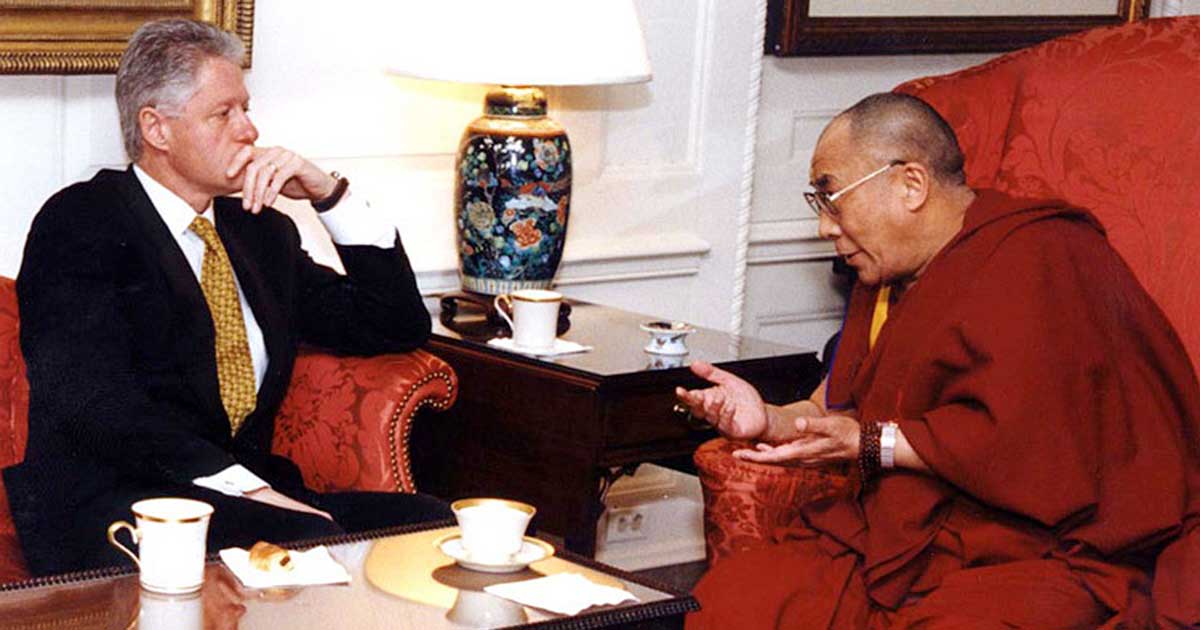
His Holiness in the White House with President Clinton in 1998.
In one of ICT’s Tibet Talks during the 2020 election, Greg Craig, the first special coordinator for Tibetan issues, revealed a surprising detail about one of His Holiness’ trips to the White House during the Clinton-Lewinsky scandal, the earliest political controversy that I can remember living through.
At one point, Craig recalled, His Holiness asked if everyone could leave the room so he could be alone with the president and first lady. “He stayed on and talked to Mr. and Mrs. Clinton for another 25, 30 minutes,” Craig told ICT. “So not only was he a great leader of a great religion and venerated around the world, but he became a very special marriage counselor, I think, at that particular moment.”
Post-presidency
His Holiness appears to have played a similar role as a source of wisdom for Clinton’s successor, George W. Bush. Paula Dobriansky, the special coordinator from 2001-09, also appeared in an ICT Tibet Talk, during which she said she witnessed the relationship between Bush and the Dalai Lama “not only come together firmly but truly grow.” “The two of them are very compassionate about the importance of democracy,” Dobriansky said.
After his presidency, Bush famously exhibited a portrait he made of the Dalai Lama, calling him “a very sweet man, and I painted him as sweetly as I could.” When His Holiness turned 85 last year, Bush sent him a video message saying, “I admire you, I care for you, and I love you.”
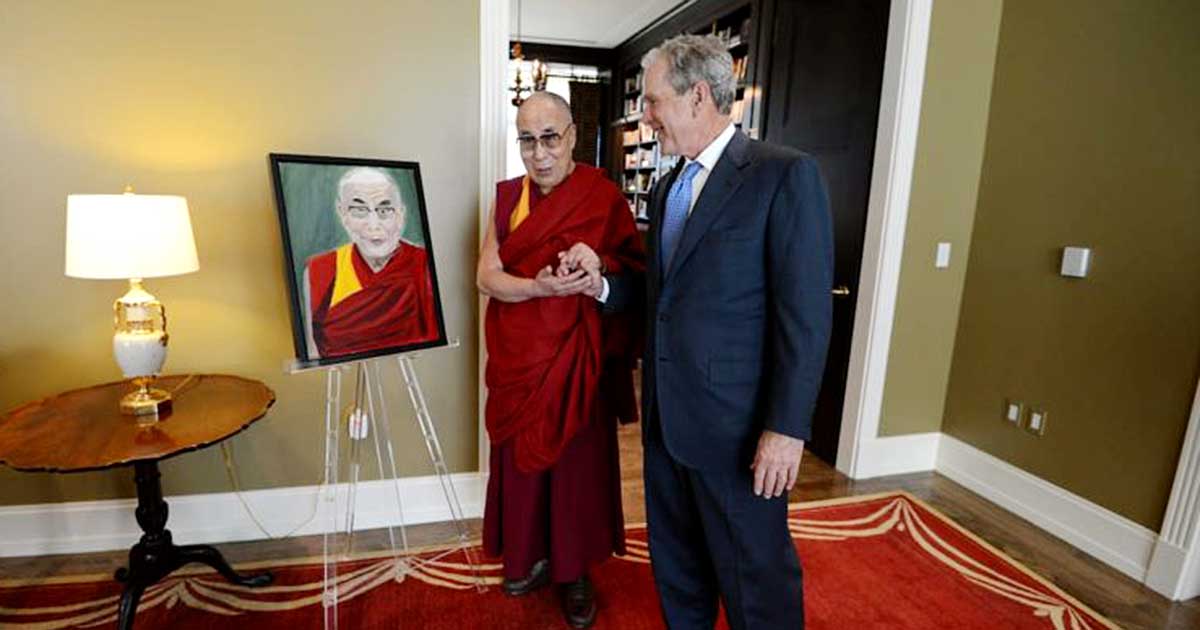
Which one is real? The Dalai Lama stands next to President George W. Bush’s portrait of him.
President Obama also seems to have maintained his respect for the Dalai Lama post-presidency. Recently, the Skimm’ asked Obama which world leaders he would want in a group text. His first response: “Dalai Lama. Love that guy.” Obama later added Pope Francis, German Chancellor Angela Merkel, former Indian Prime Minister Manmohan Singh and Queen Elizabeth to the list.
In December 2017, about a year after he left office, Obama again met with His Holiness in New Delhi. Kasur Tempa Tsering, an ICT board member and the India and East Asia coordinator for His Holiness’ office, said the two Nobel laureates “both spoke about promoting compassion and altruism in human beings.”
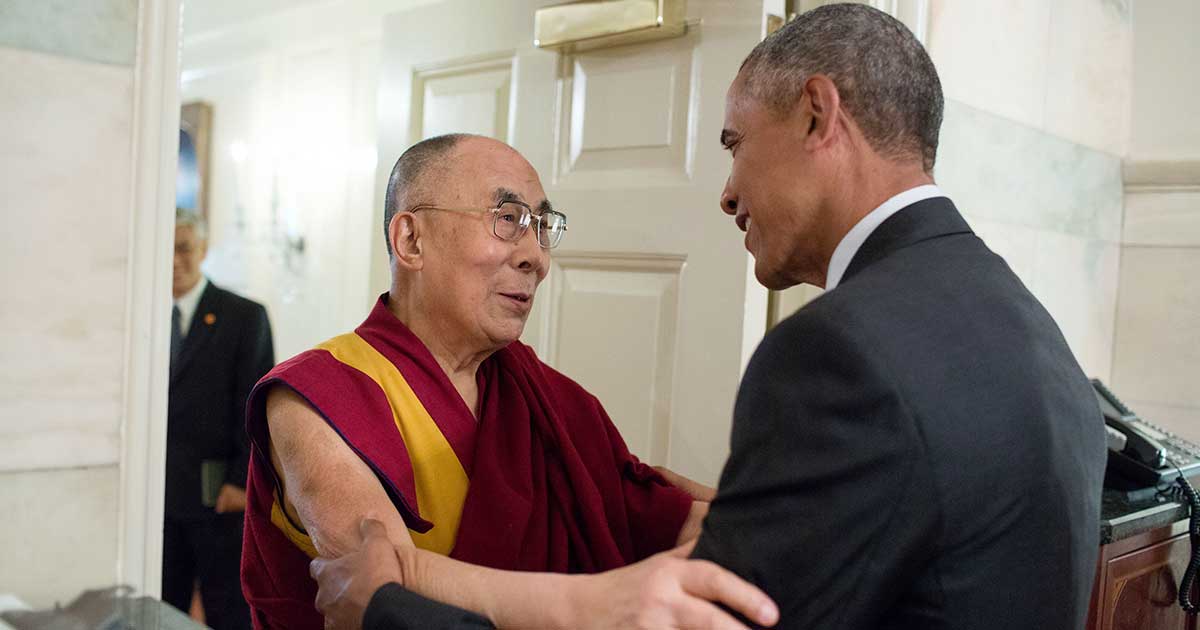
An embrace between Nobel Peace laureates: the Dalai Lama and President Obama in 2016.
Past and future
Even though Obama was the last sitting president so far to meet with His Holiness, the Dalai Lama’s contacts with the White House began long before his visit with the senior President Bush 30 years ago.
In fact, Franklin Roosevelt, who won an unprecedented third term in the White House the same year as the Dalai Lama’s enthronement in 1940, sent the young Tibetan leader a Patek Philippe gold watch when he was just 7 or 8 years old. Decades later, Sen. Patrick Leahy, D-Vt., shared an image on Facebook of His Holiness holding the watch during a visit to the US Capitol in 2016.
His Holiness has also met with former President Jimmy Carter since he left the White House, including once in Carter’s home state of Georgia in 1987.
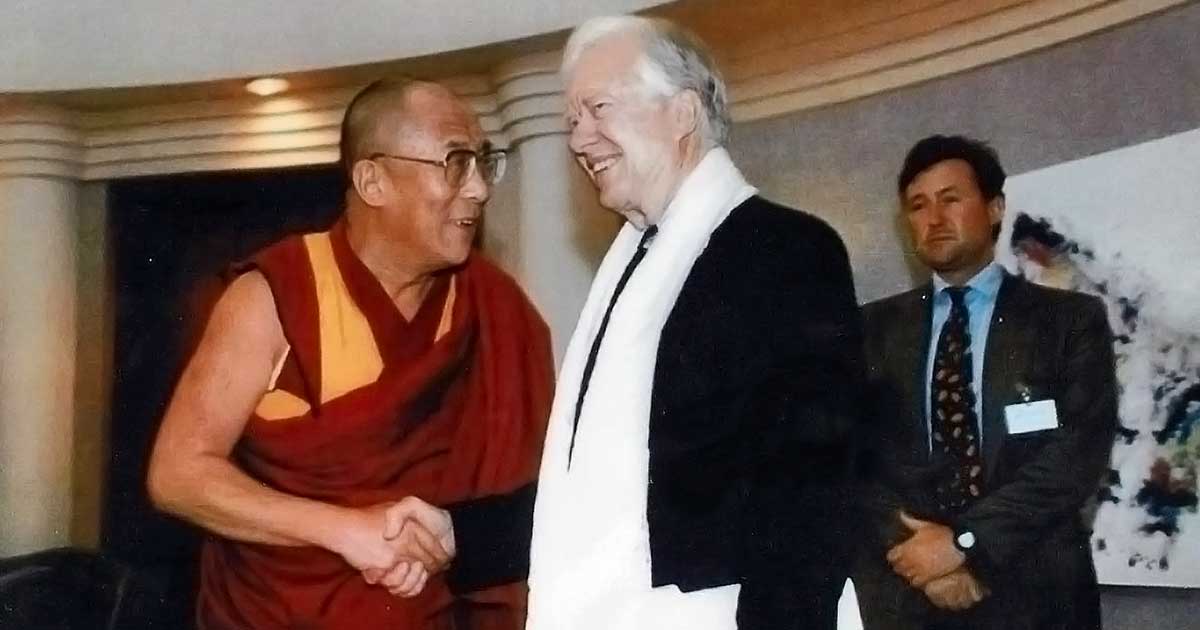
The Dalai Lama and former President Jimmy Carter in 2002.
It’s too soon to tell yet whether the present-day commander-in-chief, Joe Biden, will revive the tradition of US presidents welcoming the Dalai Lama to the White House. There are more logistical challenges now, including the lingering effects of the COVID-19 pandemic and His Holiness’ advancing age.
However, during the 2020 campaign, Biden promised to meet with the Dalai Lama as president, just as he met with him when he was a senator. His administration has also, in my opinion, gotten off to a promising start on Tibetan issues. That has included Secretary of State Antony Blinken, whom many see as Biden’s most trusted foreign policy advisor, raising Tibet in his first call with China’s top diplomat in February.
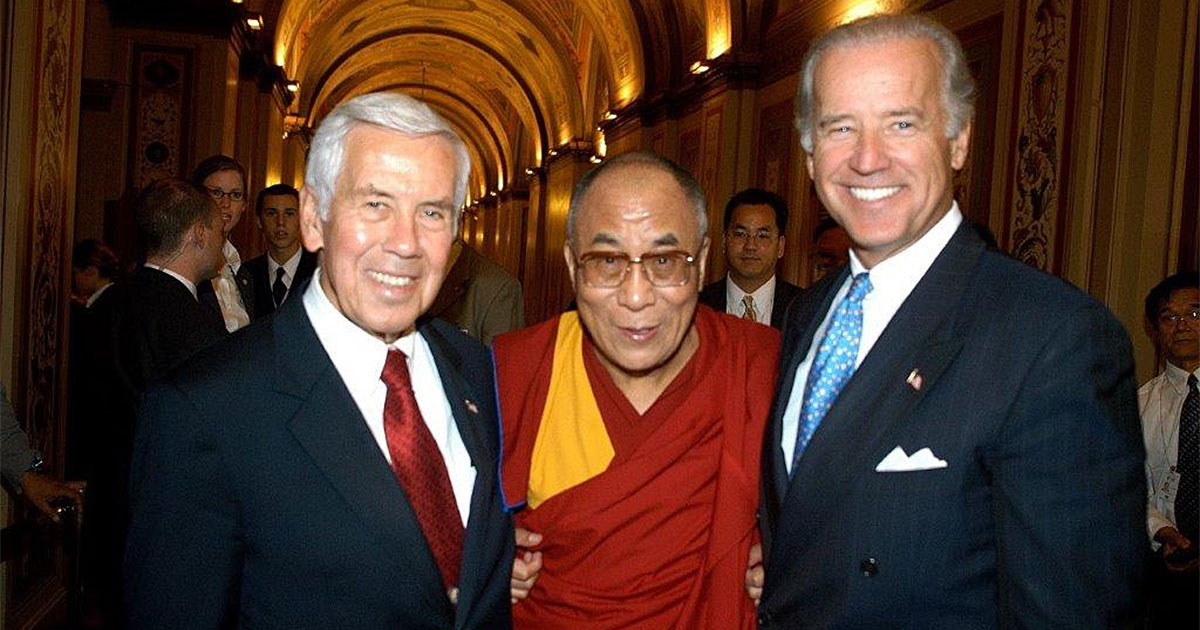
Pressure from China
I’m sure this will come as no surprise, but I hope Biden and Vice President Harris will be able to meet with His Holiness, either in the White House, in India or through some kind of virtual gathering. I desire that not just as a member of ICT’s community of compassion, but as an American citizen.
Let me go back to His Holiness’ first trip to the White House in 1991. By that time, the Dalai Lama had been coming to the United States for over a decade. He made his first political speech outside of India when he addressed the bipartisan Congressional Human Rights Caucus (now the Tom Lantos Human Rights Commission) in 1987. He received the Nobel Peace Prize in 1989 and was one of the most respected people on the planet.
Despite all that, his meeting with Bush came as a surprise. According to The Washington Post, the president’s supporters in Congress only found out about it one day in advance (Bush had previously declined to speak with the Dalai Lama two years earlier). The meeting did not appear on Bush’s public schedule, nor was there a public report afterward. Fitzwater, the White House press secretary, appeared to downplay their talk, emphasizing His Holiness’ role as a religious leader over his then-role as the political head of the Tibetan people. Subsequent administrations have used the same tactic.
No doubt part of the reason for that has been the enormous pressure China puts on any country whose leaders dare to host His Holiness. As a result, several countries have shamefully backed away from the Dalai Lama and Tibet altogether.
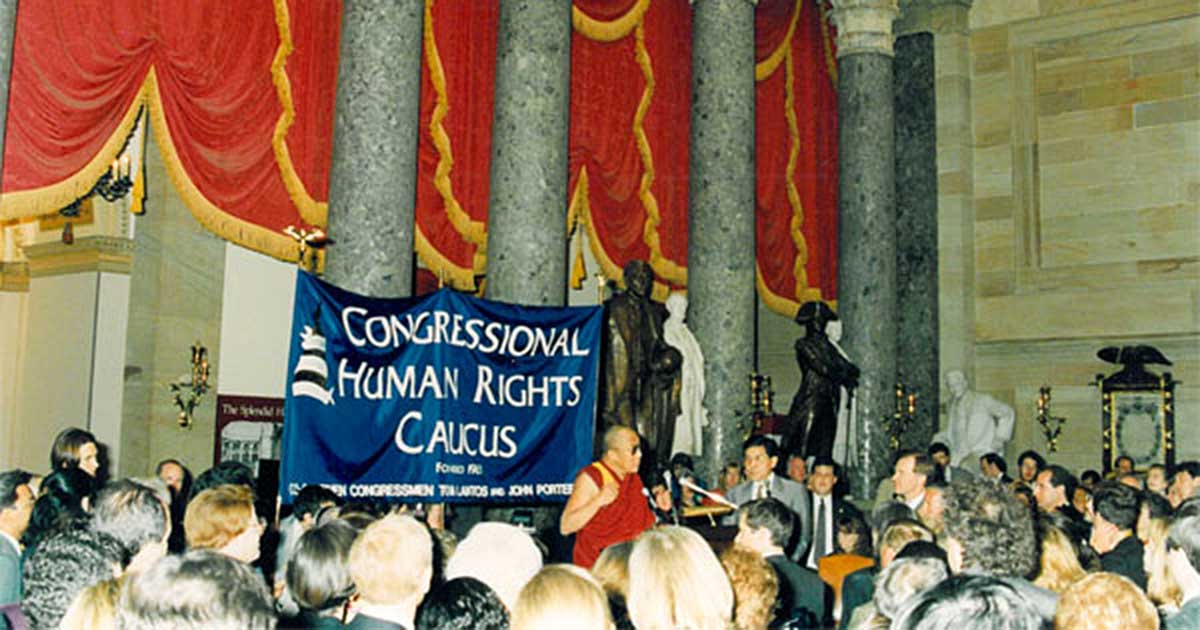
His Holiness addressing the Congressional Human Rights Caucus in 1987, his first political speech outside India.
“What America is supposed to be”
China’s pressure was also there 30 years ago when His Holiness first visited the White House. At the time, a senior Bush administration official told The Washington Post, “Of course, we have heard from the Chinese on this, and of course they would prefer no meeting.
“But,” the official added, “the Dalai Lama is a leader in human rights, a religious leader and the president wants to meet with him.” (It must have helped that Bush’s cousin, Elsie Walker, was a longtime supporter of Tibet who urged the president to receive His Holiness.)
Before his meeting with Bush, the Dalai Lama was surprisingly (to me anyway) blunt in his criticism of US policy, labeling it “unequal and unfair” for assisting some countries like Kuwait (remember that this was the time of the Gulf War) while not doing as much for a place like Tibet. As an immigrant and a man of color, I’m unhappily aware of the injustice this country is capable of. But I feel my background also gives me greater appreciation for America’s highest ideals. And I see those ideals come to life whenever our leaders embrace His Holiness.
Looking back on the 30th anniversary of the Dalai Lama’s first visit to the White House, I couldn’t help but think of something our ICT Chairman Richard Gere said during this year’s State Department reception for “Losar,” the Tibetan New Year. The event was itself a positive sign about US support for Tibet, as it marked the first time a secretary of state had taken part in the holiday celebration.
But Gere made it even more special by recalling that glorious day in 2007 when the Dalai Lama received the Congressional Gold Medal in the US Capitol Rotunda. (President George W. Bush spoke at the ceremony, the only time a sitting president has met with His Holiness in public.)
“When His Holiness spoke, I think everyone was in tears,” Gere recounted. “Again, this feeling that this is what America is supposed to be. In that moment, the Dalai Lama was the first among Americans. And I think we also maybe reclaimed our ideals.”
ICT Chairman Richard Gere discusses American ideals at the State Department’s 2021 Tibetan New Year event.
Thirty years ago, as he was about to make his first visit to the White House, the Dalai Lama said America should stand on its principles in international relations. As we mark the anniversary of that happy, historic event, we should continue to push our country to follow His Holiness’ advice by standing as Americans with the Dalai Lama and the people of Tibet.

Thank you Mr. Ashvin Verghese la (la is a connotation of respect in honorific Tibetan language) for this article full of evidence to prove HH the XIV Dalai Lama’s historic relationship with the then Presidents of United States of America. It is great source of learning for a Tibetan like me & will also share with my colleagues & Tibetan youths who I come in contact by the nature of my job & also as a responsible Tibetan adult. You have so beautifully captured whole thing that I felt I was among them & physically present during those historical moments. You made me understand the ideals for which America stands for & how patriotically the then Presidents have executed them despite the usual threats from People’s Republic of China which is not a surprise. For China just need an excuse to poke their nose & deter wise people from doing good work for the good of humanity. You also made me feel more grateful to United States of America for doing heir best in resolving Tibetan issue by standing on the ideals which America is known for & not just stopping there but going beyond in supporting the Tibetans in Exile in preserving our culture & traditions as well as providing Scholarships to study in the best of the Universities and I am one of those lucky few. I can confidently say that all Tibetans are equally grateful to your country for being there when Tibet needed the most & none of us can intentionally or unintentionally ever forget what your country did for us Tibetans! We as Tibetans must live with the virtues/secular ethics that HH the Dalai Lama symbolises as HH followers & it is our utmost duty to pay homage & gratitude to those who stood with us in times of challenge – the dark days in our history by standing up for the ethics HH has taught us & for which Tibet is known for. It is with this intent I took to pen you few words of gratitude though my English is not as good as yours yet I didn’t shy away from letting you & your country know we as Tibetans will always be grateful & in return the least we can do is pray for the people of America to be stronger, healthier & live up to your ideals as always & also appeal to your government as the most powerful nation continue standing & speaking up for UNIVERSAL human rights & be the voice for the voiceless around the world that are subjected to brutal tortures, violation of human rights & dignity by dictatorial regimes.
I also thank you for reminding us the efforts put forth by ICT & it’s members including Richard Gere for the past many years in our freedom struggle. This too is truly appreciated & pray that the Triple Jewels bless all of you who work for Tibet & Tibetan cause & give you the strength both mentally & physically to continue working indefatigably for Tibetan cause. May HH the Dalai Lama live for aeons & aeons! Boed Gyalo! I must also thank Ms. Tenchoe Gyatso la for sharing this invaluable article & academic resource!
With immense gratitude,
Dear Donkar Wangmo la, sorry for my late reply. Thank you for this most kind and thoughtful response to my blog post! I am delighted to hear that you found it a great source of learning, and I am even more pleased to know that you planned to share it with your colleagues and Tibetan youths. We are fortunate in the United States to have such a vibrant community of Tibetan Americans who have brought their magnificent culture and religion with them for all Americans to benefit from. I am proud of US support for Tibet and proud to work for ICT on behalf of His Holiness’ vision. Thank you for all of your support!